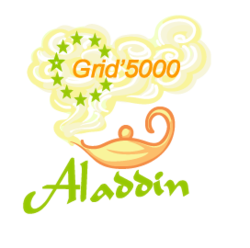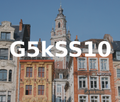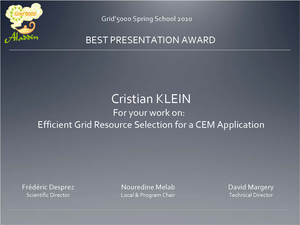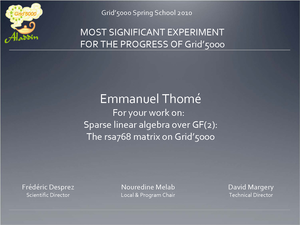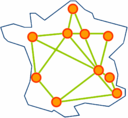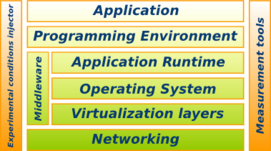Grid5000:Home
ALADDIN-G5K : ensuring the development of Grid'5000for the 2008-2012 periodAn infrastructure distributed in 9 sites around France, for research in large-scale parallel and distributed systems Engineers ensuring the development and day to day support of the infrastructure are mostly provided by INRIA, under the ADT ALADDIN-G5K initiative. |
Latest newsG5kSS10 Challenge winner: deploying a sky computing environment (3 clouds) based on Nimbus in 30mn !The Grid'5000 Spring School challenge winner is Pierre Riteau, who demonstrated the deployment of a sky computing environment based on nimbus in 31mn ! These include the deployment of the nodes using kadeploy3 and their configuration to form a sky computing environment located in 3 sites and managing 278 VMMs providing 1628 virtual cpus and 2 124 Gb of memory. Details in the winner's presentation, or on Dr Dobbs. Grid'5000 Spring School 2010 award winners announcedThe Grid'5000 spring school took place between April 6th, 2010 and April 9th, 2010 in Lille. This highly successful edition brought together 78 registered participants for 4 days of tutorials and talks focusing on best-practices, results and links to other tools for experiment-driven research. The presentation program has been updated with the slides of the presentations. Most practical sessions are available to people that did not take part during the school.
Two awards were given for presentations made during the event :
Latest updated experiment descriptions{{#experiments:3}} Latest updated publicationsFive random publications that benefited from Grid'5000 (at least 2517 overall):
Research in Grids - Production Grids workshop held October 13th, 2009L’Institut des Grilles (IdG) et l’action Aladdin INRIA lancent un appel commun à propositions pour dynamiser les recherches à l’interface entre la recherche sur les grilles, les grilles de recherche, et les grilles de production. Le colloque présentera les questions ouvertes aux interfaces et les projets proposés dans le cadre de cet appel, afin de favoriser la création de nouveaux réseaux. Le but de la journée est de faire émerger des synergies. La présentation de travaux en cours est donc vivement encouragée. Plus d’informations. --- |
Grid'5000 at a glance
- Grid'5000 is a scientific instrument for the study of large scale parallel and distributed systems. It aims at providing a highly reconfigurable, controlable and monitorable experimental platform to its users. The initial aim (circa 2003) was to reach 5000 processors in the platform. It has been reframed at 5000 cores, and was reached during winter 2008-2009.
- The infrastructure of Grid'5000 is geographically distributed on different sites hosting the instrument, initialy 9 in France. Porto Alegre, Brazil is now officially becoming the 10th site.
Sites:
- Grid'5000 is a research effort developping a large scale nation wide infrastructure for large scale parallel and distributed computing research.
- 17 laboratories are involved in France with the objective of providing the community a testbed allowing experiments in all the software layers between the network protocols up to the applications.
The current plans are to extend from the 9 initial sites each with 100 to a thousand PCs, connected by the RENATER Education and Research Network to a bigger platform including a few sites outside France not necessarily connected through a dedicated network connection. Sites in Brazil and Luxembourg should join shortly.
All sites in France are connected to RENATER with a 10Gb/s link.
This high collaborative research effort is funded by INRIA, CNRS, the Universities of all sites and some regional councils.
Initial Rationale
The foundations of Grid'5000 have emerged from a thorough analysis and numerous discussions about methodologies used for scientific research in the Grid domain. A report presents the rationale for Grid'5000.
In addition to theory, simulators and emulators, there is a strong need for large scale testbeds where real life experimental conditions hold. The size of Grid'5000, in terms of number of sites and number of processors per site, was established according to the scale of the experiments and the number of researchers involved in the project.
Current funding
As from June 2008, INRIA is the main contributor to Grid'5000 funding.
INRIA |
CNRS |
UniversitiesUniversity Joseph Fourier, Grenoble |
Regional councilsAquitaine |
